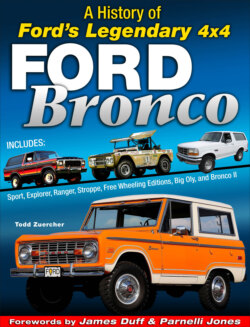Читать книгу Ford Bronco: A History of Ford's Legendary 4x4 - Todd Zuercher - Страница 26
На сайте Литреса книга снята с продажи.
Rear Axle
ОглавлениеThe Bronco rear axle was Ford’s familiar 9-inch (named for the diameter of its ring gear), the first variant of which had been introduced in Ford’s 1957 cars. By the time of the Bronco’s introduction, the 9-inch rear axle had gained a reputation for strength and ease of gear changes due to its drop-out differential assembly. In the Bronco, it was offered with two capacities: 2,780 pounds and 3,300 pounds, now known as the “small bearing” and “big bearing” rear ends, respectively. Each offered the option of a clutch-type limited-slip (Traction-Lok in Ford-speak) and axle ratios of 4.11 and 4.57:1 behind the 6-cylinder engine. When the V-8 was introduced, Ford added a 3.50:1 ratio to the mix. The 1966 rear axle housing is unique and identifiable from other years of the first generation by an inspection/fill plug on the rear of the housing.
Although the 9-inch rear axle was appreciated for its strength, it did suffer in the ground clearance department compared to the axles offered in the CJ-5 and Scout, hanging 1.5 to 2 inches lower than the competition. The rear brakes on all rear axles had a 10-inch diameter and measured 2.5 inches wide.
The Bronco’s header front suspension was one of its strongest selling points when it was introduced and continued to be a prime reason for its success; none of its primary competitors switched to coil springs during the Bronco’s lifetime. At its introduction, Ford touted its superior ride characteristics, improved handling, and ability to allow tighter turning circles as its key attributes.
Coil springs generally ride better than their leaf-spring counterparts due to the lack of internal friction inherent in leaf springs. Because the leaf springs on the front of solid-axle vehicles must serve a locating function in addition to providing ride comfort, they end up being stiffer because they are mounted farther inboard from the wheels than coils to achieve an acceptable turning radius.
Ford’s radius arm suspension also had excellent anti-dive characteristics, with Ford Bronco engineer Paul Axelrad noting that the Bronco showed 102 percent anti-dive when 70 percent of the braking was accomplished at the front wheels. That is important during panic stops and when performing snowplowing chores with a heavy plow on front.
